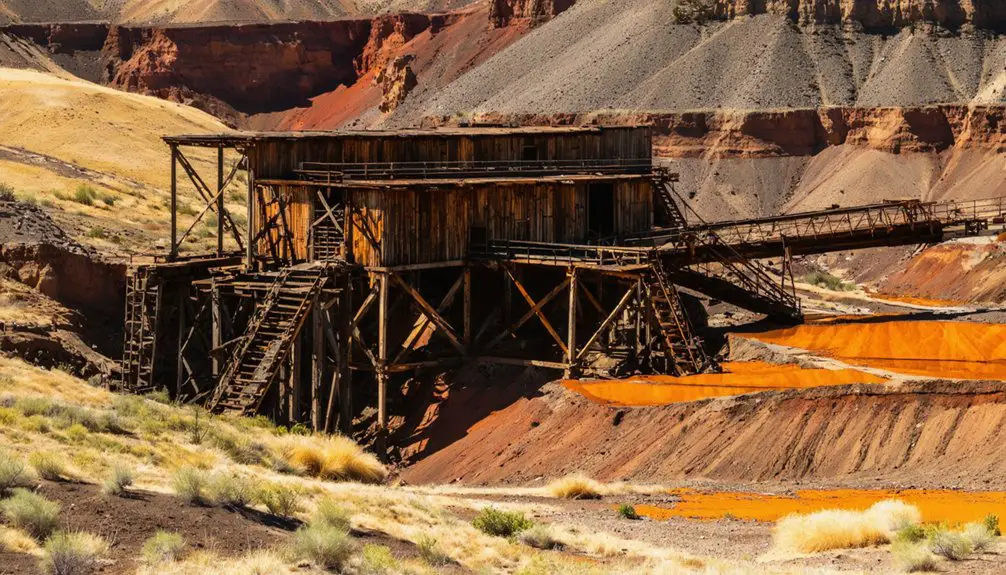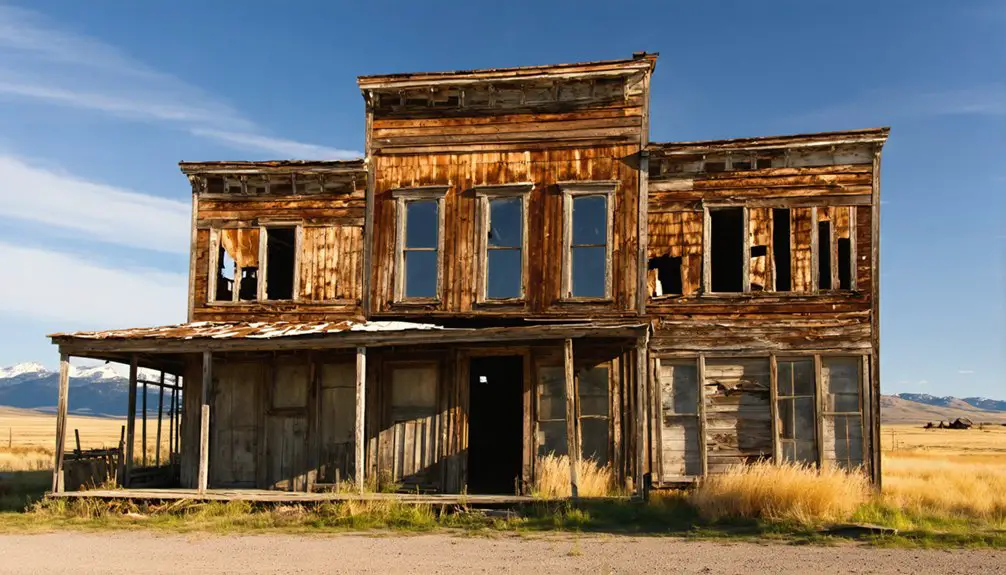You’ll discover Comet, Montana’s remarkably preserved 35-acre ghost town, which thrived during the 1880s-1890s as the state’s premier mining venture. After John W. Russell’s 1869 silver discovery, the town grew to 300 residents with over 20 saloons, generating $20 million in mineral wealth from silver, gold, copper, lead, and zinc. Today, you can explore the 12-block layout with its weathered structures and industrial remnants, while the site’s complex legacy of prosperity and environmental impact unfolds.
Key Takeaways
- Comet became a thriving Montana mining town after silver was discovered in 1869, generating $20 million in mineral wealth during its peak.
- The town reached 300 residents with over 20 saloons, a school, and various amenities before declining in the early 1900s.
- The 35-acre site features preserved mining structures and a 12-block town layout, accessible to visitors on private land.
- Mining operations left significant environmental impacts, leading to cleanup efforts by Montana’s Department of Environmental Quality in 1997.
- Historic structures include ore processing facilities and residential buildings, offering glimpses into Montana’s mining heritage.
The Rise of a Mining Frontier Town
When John W. Russell discovered silver ore in 1869, you’d never have guessed it would transform into a bustling frontier settlement. After staking his Comet claim in 1874, the area’s mining techniques remained primitive due to its remote location and poor infrastructure.
By 1876, plans emerged for a proper miners’ town, with surveyors mapping 12 blocks and 120 plots for cabin construction using local timber. Miners earned between $3 to $3.50 per day working in the mines during the 1880s.
Surveyors carved civilization from wilderness, sketching a frontier town of 12 blocks where silver miners would soon build their homes.
The community dynamics shifted dramatically when the Helena Mining and Reduction Company took control in 1883, modernizing operations with a new smelter and concentrator. The company’s success was largely due to Samuel T. Hauser’s leadership as director.
You’ll find the town’s rapid development reflected in its growing amenities – a post office established in 1877, about 20 saloons during peak years, and a school serving 20 pupils.
The Northern Pacific Railroad‘s branch line to Wickes finally connected Comet to larger markets.
Peak Years of Mineral Wealth
The Comet Mine’s remarkable prosperity took shape during the 1880s and 1890s, as the Helena and Livingston Smelting and Reduction Company transformed the operation into Montana’s premier mining venture.
You’ll find evidence of their mining innovations in the 100-ton concentrator and extensive smelting facilities at Wickes, while the Northern Pacific Railway’s branch line expansion facilitated unprecedented ore transport capabilities.
The mine’s economic resilience proved exceptional, maintaining profitability even during the devastating Panic of 1893 when silver prices crashed nationwide. Like the dirty snowballs of space that survive long journeys through the solar system, the mine showed remarkable endurance.
With a thriving population of 300 residents, Comet’s vibrancy manifested in over 20 saloons and robust community infrastructure.
The Alta-Montana Company’s investment of $500,000 in 1879 laid the groundwork for future success and development.
The operation generated an impressive $20 million in diverse mineral wealth, including lead, zinc, copper, silver, and gold, cementing its position as the district’s richest producer.
Life in a Montana Mining Community
You’d have found daily life in Comet’s mining community shaped by the constant rhythm of rotating shifts and the ever-present background noise of mining operations.
Your family’s living conditions would’ve been challenging, with housing often situated uncomfortably close to industrial activity, while children split their time between work and play amid the industrial landscape. The community featured saloons and shops that served the needs of miners who had little time for daily chores. Many miners relied on candle-lit helmets to illuminate their dangerous underground work.
If you were running a household, you’d likely have engaged in multiple income-generating activities, from taking in boarders to providing services like laundry or baking, ensuring your family’s survival in this rugged Montana mining town.
Daily Work and Play
Life in Comet revolved around the constant rhythm of mining operations, where workers earned $4-5 per day extracting valuable ores during the Great Depression.
You’d find miners facing mining challenges around the clock, with the constant drone of the 200-ton concentrator becoming part of daily life. Despite the industrial setting, community resilience shone through as families adapted to their surroundings. The Northern Pacific Railroad provided crucial transportation for both workers and materials. The town’s rich silver deposits fueled its growth to over 1,000 residents during its peak years.
While you couldn’t find saloons or churches on company land, you’d see children playing in open fields and families enjoying picnics amid the industrial backdrop.
The boarding houses served as social hubs, where workers shared meals and stories. Though you’d need to travel to nearby Basin for commerce, Comet’s tight-knit community made the most of their shared spaces, from the local schoolhouse serving 20 students to the communal dining areas.
Family Living Conditions
Living conditions for families in Comet centered around company-owned housing, where miners and their loved ones adapted to the realities of an industrial mining town.
Despite the challenges, family resilience shone through as residents created meaningful lives within the constraints of company control.
You’d find these key aspects of daily life:
- Housing options ranged from modest cabins to boarding house accommodations at 75 cents per day
- Community gatherings focused on outdoor activities like picnics in grassy areas
- Children attended a local school with about 20 pupils, fostering education
- Families relied on nearby Basin for shopping and services
While basic amenities existed, including plumbing in the boarding house by 1934, you’d need to adjust to constant mill noise and limited private enterprise opportunities in this company-controlled environment.
The boarding house stability worsened over time as structural problems emerged, causing safety concerns for residents.
The town’s decline became evident when the ore played out around 1900, forcing many families to seek opportunities elsewhere.
The Inevitable Decline
Although Comet’s mines yielded impressive quantities of lead, zinc, silver, gold, and copper during its peak, the town’s decline became inevitable as ore deposits began depleting in the early 1900s.
The economic challenges forced multiple ownership changes as companies struggled with resource management and dwindling profits.
You’ll find that despite surviving the 1893 silver panic, Comet couldn’t overcome the perfect storm of depleted minerals, falling commodity prices, and rising operational costs.
Environmental Legacy and Restoration

While Comet’s mining operations brought prosperity during its heyday, they left behind a devastating environmental legacy of toxic metal contamination that persisted for over eight decades.
You’ll find the mine’s waste rock and tailings severely impacted High Ore Creek and the Boulder River watershed, with dangerous levels of arsenic, copper, zinc, cadmium, and lead threatening both human and wildlife populations.
In 1997, Montana’s DEQ launched a thorough ecological restoration project that achieved four critical objectives:
- Containment of toxic mine tailings to prevent further leaching
- Protection of drinking water sources for people and livestock
- Stabilization of contaminated soil and sediment deposits
- Restoration of aquatic habitats for native fish species
Exploring the Ghost Town Today
Today’s visitors to Comet can explore a remarkably preserved snapshot of Montana’s mining heritage across 35 acres of historical terrain.
You’ll find abandoned structures including a prominent ore hopper, processing facilities, and weathered residential buildings that tell the story of this once-bustling mining community.
As you navigate the 12-block town layout, you can walk through both industrial and residential zones, where historical artifacts from the late 19th and early 20th centuries remain visible.
High Ore Creek divides the site, with mine buildings on one side and town remains on the other.
While there’s limited interpretive signage, you’re free to conduct self-guided tours of the area.
Though minimal signs guide your way, feel free to wander and discover the historic grounds at your own pace.
Remember you’re on private land that allows public access, so explore responsibly while watching for structural and terrain hazards.
Frequently Asked Questions
Are There Any Reported Paranormal Activities or Ghost Sightings in Comet?
You won’t find documented ghost stories or supernatural encounters in Comet’s historical record. Despite its abandoned state, there’s no credible evidence of paranormal activity in this former mining town.
What Happened to the Mining Equipment and Machinery After the Town’s Abandonment?
Like scattered bones of a fallen giant, mining relics lay abandoned. You’ll find most equipment was sold off in 1941, while remaining machinery deteriorated from weather and vandalism, with no preservation efforts attempted.
Which Original Buildings From Comet’s Heyday Are Still Standing Today?
You’ll find the two-story boarding house, bunkhouse, ore processing building, ore hopper, and several miners’ cabins still standing, though their historic preservation status remains precarious due to their architectural significance.
Were There Any Major Accidents or Disasters During Comet’s Mining Operations?
You’ll be surprised – despite Montana’s deadly mining history, there aren’t any documented major mining accidents or disaster reports from Comet’s operations, though the mine faced typical underground hazards and eventual flooding.
Did Any Famous or Notable Historical Figures Ever Visit Comet?
You won’t find records of famous visitors to this mining town, though Samuel T. Hauser and John W. Russell, both significant figures in Montana’s mining history, were involved with its operations.
References
- https://www.explorebigsky.com/the-glory-days-of-comet-montana/22805
- https://www.legendsofamerica.com/mt-comet/
- https://en.wikipedia.org/wiki/Comet
- https://www.youtube.com/watch?v=I-zDRZLjhuk
- https://crystalgemstoneshop.com/blogs/stones/twinkle-in-the-ground-the-comet-mine-of-montana
- https://www.youtube.com/watch?v=YU0y9_5Ylbg
- https://www.abandonedspaces.com/towns/montana.html
- https://theclio.com/entry/6234
- https://archiveswest.orbiscascade.org/ark:80444/xv647063
- https://mths.mt.gov/education/MiningChildhood/02ChapFinn64-110.pdf



